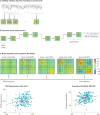Cognitive and behavioural flexibility: neural mechanisms and clinical considerations
- PMID: 33536614
- PMCID: PMC7856857
- DOI: 10.1038/s41583-021-00428-w
Cognitive and behavioural flexibility: neural mechanisms and clinical considerations
Abstract
Cognitive and behavioural flexibility permit the appropriate adjustment of thoughts and behaviours in response to changing environmental demands. Brain mechanisms enabling flexibility have been examined using non-invasive neuroimaging and behavioural approaches in humans alongside pharmacological and lesion studies in animals. This work has identified large-scale functional brain networks encompassing lateral and orbital frontoparietal, midcingulo-insular and frontostriatal regions that support flexibility across the lifespan. Flexibility can be compromised in early-life neurodevelopmental disorders, clinical conditions that emerge during adolescence and late-life dementias. We critically evaluate evidence for the enhancement of flexibility through cognitive training, physical activity and bilingual experience.
Conflict of interest statement
The author declares no competing interests.
Figures



References
-
- Scott WA. Cognitive complexity and cognitive flexibility. Sociometry. 1962;25:405–414. doi: 10.2307/2785779. - DOI
Publication types
MeSH terms
Grants and funding
LinkOut - more resources
Full Text Sources
Other Literature Sources
Medical

